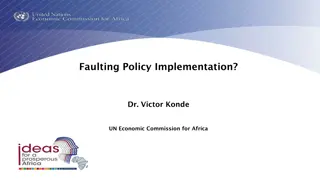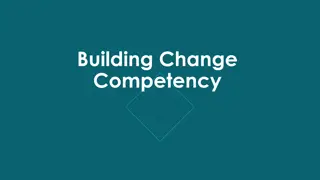Theories and Strategies for Effective Policy Change
Explore the intricacies of strategic planning, outcome mapping, change theories, policy windows, and more in the realm of policy entrepreneurship and advocacy. Learn about key concepts such as large leaps theory, policy streams theory, and how think tanks can influence policy decision-making processes. Discover the importance of monitoring outcomes, engaging new actors, and seizing strategic opportunities to drive impactful policy change.
Uploaded on Sep 24, 2024 | 0 Views
Download Presentation

Please find below an Image/Link to download the presentation.
The content on the website is provided AS IS for your information and personal use only. It may not be sold, licensed, or shared on other websites without obtaining consent from the author. Download presentation by click this link. If you encounter any issues during the download, it is possible that the publisher has removed the file from their server.
E N D
Presentation Transcript
Strategic planning Enrique Mendizabal 2022
ODIs policy entrepreneurship training and planning: ROMA Outcome Mapping outcome statements and progress markers Approaches CGD v ODI back in 2009 Words before graphs
Context how change happens or does not happen? Monitoring and learning Objectives (outcomes) ROMA revisited Strategy Capacities/resources
Global theories Large Leaps or Punctuated Equilibrium theory Policy Windows or Agenda-Setting theory Coalition theory or Advocacy Coalition Framework Power Politics or Power Elites theory Regime theory These are mutually exclusive Global theories
Large leaps theory Changes in policy and institutions occur when the right conditions are in place: like seismic evolutionary shifts . When: Global theories An issue is faced with a fundamental questioning or re-definition; New actors, of significant importance, become involved in an issue; or An issue receives a sudden burst of attention from the public the media or key actors.
Large leaps what can think tanks do to get us past the tipping point? Work with social movements, advocacy organisations Research to break consensus Global theories Invite new actors into the discussion by reframing research Develop complete alternatives to the status quo
Policy window or policy streams theory Change happens when two of the following three stream come together (ideally all three): Problems Global theories Policies or solutions Politics or political opportunity
Policy window what can think tanks do to create or take advantage of a window? Strategic opportunism, communications as orchestra Track and plan around windows Global theories Establish a credible brand connected to the window Focus research on explaining the problems and develop practical and actional solutions (windows close fast) Prepare and train communications and engagement on policy window Create a window, e.g. through a report, award
Coalition theory Change happens through the coordinated activity of a range of individuals (or organisations) with the same beliefs and objectives. Global theories This is linked to Diane Stone s new work on (global) epistocracy.
Coalition theory what can think tanks do? Learn how to work in and with coalition be prepared to share attribution Co-develop knowledge Global theories Focus on nurturing spaces for debate Focus on building consensus within coalitions Champion and support individuals with the power o mobilise others
Power politics theory The power to bring about change is held by a few. Change happens when it is in their interest to promote or allow it. Think tanks belong to the elite and are used by the elite (could be: State, private sector, individuals, etc.) Global theories But, from Gaventa: power is often invisible or hidden
Power politics theory what can think tanks do when elites call the shots? Target a few key powerful players Adopt a revolving door approach, secondments, commissions Global theories Partner and cozy up to influential actors Focus on incremental change elites do not like seismic change
Regime theory Regimes award power to govern Change can only happen when several regimes (collective groups of individuals and organisations) change Global theories Change is hard because it is expensive to change regimes Regimes are good at conceding small wins to avoid big reforms
Regime theory what can think tanks do? Think tanks should remember they belong to a regime so they could: Study the regimes that govern their fields Global theories Prop-up current or alternative regimes with evidence to strengthen their arguments Seek to undermine existing regime s power by targeting their evidence base Position themselves at the margins of their regime
Tactical theories Messaging and Frameworks theory Media Influence or Agenda-Setting theory Grassroots or Community Organizing theory Group Formation or Self-Categorization theory Diffusion theory or Diffusion of Innovations These are not mutually exclusive Tactical theories
Messaging and frameworks theory Change can happen as a consequence of how a problem is presented and partly by a decision maker s norms, habits, and personal characteristics People prefer options that are certain even if the end results are less beneficial Tactical theories People may make different choices given different contexts or scenarios
Messaging and frameworks theory what can think tanks do? Frame (or re-frame) issues (problems and solutions) to respond to the different audiences and to a specific moment/ circumstance Develop and advocate for certain options/alternatives/change Tactical theories Help develop and socialise a common vision of change
Media influence theory Change happens when the media* wants it to happen The media determines what issues are discussed and therefore what issues may be subject to reform Tactical theories The media, itself, has an agenda The media acts as a filter of credibility and legitimises who gets to make decisions
Media influence theory what can think tanks do? Research and track the media s own agenda Invest in public engagement more broadly Work on your visibility and credibility with the media s own audiences Try to place your ideas on the agenda and keep them there for as long as possible (communications as orchestra) Tactical theories
Grassroots theory Change can happen from the bottom up people can take power from the elites Power bases can shift through actions or events Change happens when institutions change not just individuals Tactical theories
Grassroots theory what can think tanks do? Reach out to social movements legitimate them Inform (or provide information to) grassroot, community organisations, etc. Tactical theories Help identify power shifting actions or events Treat power shifting events as windows of opportunity
Group formation theory Change may happen when members from different groups come together Or change fails to happen when groups isolate from each other Tactical theories Polarisation can lead to winners take all change or stalemate
Group formation theory what can think tanks do? Find unlikely allies by creating new spaces or groups with more common ground Work in and with networks Tactical theories Nurture spaces for deliberation and debate
Diffusion theory Change happens through the progressive adoption of ideas/ products/ innovations by an increasingly large group of people or organisations Tactical theories Diffusion is both planned and spontaneous Diffusion is easier if the proponents are part of the system (group)
Diffusion theory - what can think tanks do? Innovations are easier to adopt if they are more complete and framed in terms relevant to the each group The messengers of the recommendations are important to maximise the probability of diffusion Tactical theories Follow IDRC s Scaling Playbook (plan for scale)
What theory best explains change/or lack of change in your field/sector/area? Question
Overview Objectives and objectives/ Outcomes Present the initiatives model from the Center for Global Development initiatives model Compare/contrast with ODI (back in 2009) A short exercise if we have time Objectives
Lets try this - we need a volunteer A guest arrives at your think tank You show him or her around the office You run into a few of your colleagues along the way and you introduce the guest to them and their work Objectives How would you do it?
Back in 2009 At CGD At ODI Objectives This Photo by Unknown Author is licensed under CC BY-NC-ND
Initiatives approach CGD (2008) 1. 2. 3. 4. 5. 6. 7. 8. 9. 10. Refine product/activity mix to suit objectives 11. Identify key decision makers 12. Hand-off initiative to others or not Choose a problem that can be solved Find the right leaders Get the money Recruit the team/working group* Sharpen problem definition and start on solution Small secretariat to do the actual work Brand early! Communicate early and often Circulate drafts Day 1 Objectives
Overview Governance and management Funding Talent Communications and engagement Partnerships and alliances Research resources and services Other Capacities/resources
Overview Would someone visiting a think tank (who has no idea what a think tank does) think that research is the most important thing that goes on there? Partnerships, governance, management, communications, digital services, human resources, finance and planning, admin and office management, cleaning, etc. Easier said than done: projects, plans and resources should follow objectives and strategy Capacities/resources
Initiatives approach CGD (2008) 1. 2. 3. 4. 5. 6. 7. 8. 9. 10. Refine product/activity mix to suit objectives 11. Identify key decision makers 12. Hand-off initiative to others or not Choose a problem that can be solved Find the right leaders Get the money Recruit the team/working group* Sharpen problem definition and start on solution Small secretariat to do the actual work Brand early! Communicate early and often Circulate drafts Capacities/resources
Governance and management Questions to consider: Does our organisation/programme need a governance arrangement? Does our org/programme need dedicated management lead/support? Do we have the right management arrangements in place? How does programme management work with other parts of the organisation? Capacities/resources
Funding Questions to consider: Do we have the right funding? Amount, timeframe, flexibility, source Capacities/resources Do we have funding for all the parts/phases of the strategy? Are we taking into account the full cost of our strategies? Are we able to manage the funding efficiently and effectively?
Talent Questions to consider: Which are the skills we need? Do we have the right team/skills? Do we know how to get them can we? Can our strategy be delivered in the midst of changes in the team? Are we inclusive, diverse, representative? Capacities/resources
Communications and engagement Questions to consider: Does the organisation have the right competencies, skills or experience? Is it able to subcontract does it have to? Is the comms team able to input into the design of the strategy? Does it have the right resources to deliver the strategy? Does it have the funds to pay for this? Capacities/resources
Partnerships and alliances Questions to consider: Do we know the right partners and networks that we need to work with? Are we able to work with them? How? Do we have the resources required for effective partnerships and alliances? Capacities/resources
Research resources Issues to consider: Data Research tools/software Equipment (space - at the office or at home) Logistical support Capacities/resources
Context how change happens or does not happen? Monitoring and learning Objectives ROMA revisited Strategy Capacities/resources























